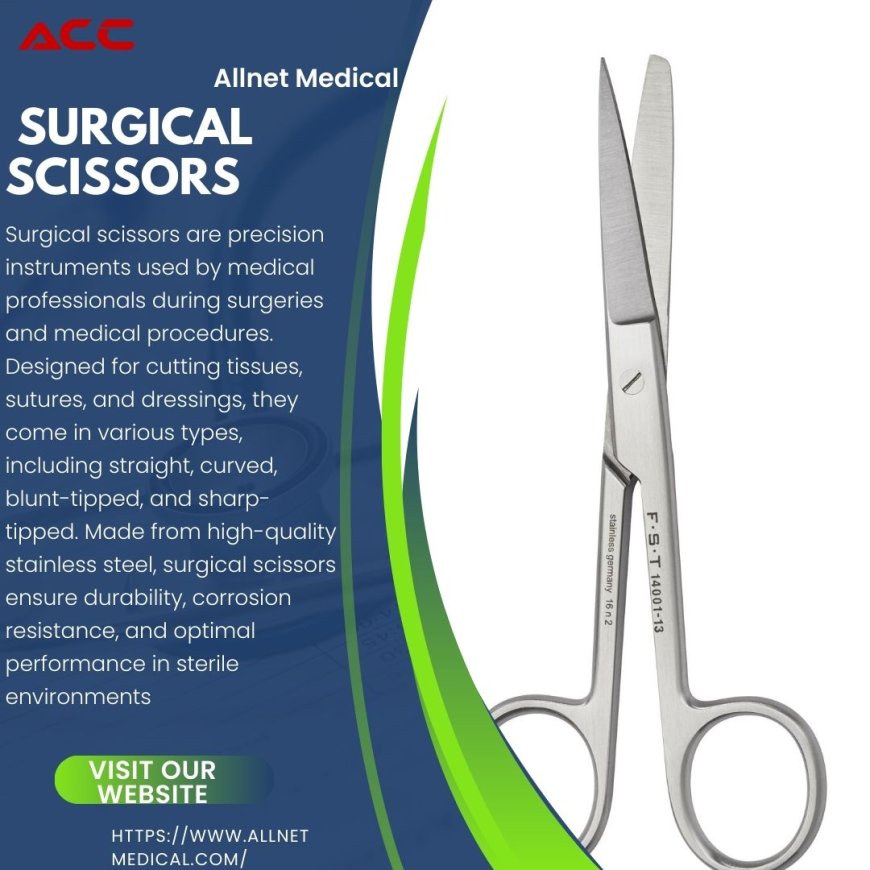How Surgical Scissors Work: A Crucial Tool in Precision Surgery
Introduction Surgical scissors are fundamental tools in the medical field, designed for precision cutting during surgical procedures. They play a critical role in enabling surgeons to perform delicate tasks, from cutting tissues to handling sutures

How Surgical Scissors Work: A Crucial Tool in Precision Surgery
Introduction
Surgical scissors are fundamental tools in the medical field, designed for precision cutting during surgical procedures. They play a critical role in enabling surgeons to perform delicate tasks, from cutting tissues to handling sutures. Among the various types, surgical operating scissors are specifically designed for use in operations, offering sharpness, control, and versatility. This article explores how surgical scissors work and why they are essential to successful surgical outcomes.
Understanding the Basic Structure
Surgical scissors are composed of two pivoting blades that move against each other, creating a cutting action. These scissors come in a variety of shapes and sizes, depending on their intended use. Typically, they consist of the following parts:
-
Blades: The sharp edges responsible for cutting tissues, sutures, or other materials.
-
Handles: Ergonomically designed for comfortable grip and control, allowing the surgeon to apply the necessary force.
-
Pivot (or Screw): Connects the two blades and allows them to move in unison.
The quality and sharpness of the blades, along with the balance and design of the handles, directly affect how well the surgical scissors function during operations.
Cutting Mechanism: How It Works
The cutting action of surgical scissors is based on the simple mechanics of two sharp blades moving past one another. When a surgeon applies pressure to the handles, the blades close together, cutting through the material placed between them.
-
Shear Force: The key to how surgical scissors work lies in the shear force created as the blades slide against each other. This action allows the scissors to cut through tissues or sutures with minimal damage to the surrounding areas.
-
Blunt vs. Sharp Dissection: Depending on the type of surgical scissors, they can either cut sharply (sharp dissection) or push apart tissues without cutting (blunt dissection). For instance, curved surgical operating scissors are used for dissecting deep tissues during surgery.
Precision and Control in Surgery
One of the most important aspects of how surgical scissors work is the precision they provide. These tools allow surgeons to make controlled cuts, ensuring that they only remove or dissect the necessary tissue. This precision minimizes trauma to surrounding tissues, reducing recovery time for patients.
Key Factors in Precision:
-
Sharpness of the Blades: Sharp blades are essential for clean, precise cuts. Surgical operating scissors are designed to maintain their sharpness over time, allowing for repeated use in surgeries.
-
Blade Length: Shorter blades provide more precision for detailed tasks, while longer blades are used for cutting larger or deeper tissues. Surgeons choose the blade length based on the specific requirements of the procedure.
Types of Movements in Surgery
The working of surgical scissors involves several different types of cutting movements, each suited to particular tasks in surgery:
-
Snipping: Small, quick cuts used to trim sutures or make fine adjustments to tissue.
-
Dissection: Cutting through or separating tissues, often using curved surgical operating scissors for deeper, more controlled cuts.
-
Blunt Dissection: Some surgical scissors, especially those with blunt tips, are used to push tissues apart rather than cutting them, a process called blunt dissection. This technique reduces the risk of damaging delicate tissues such as blood vessels or nerves.
Role of Straight and Curved Blades
The design of the blades plays a crucial role in how surgical scissors are used in operations.
-
Straight Blades: These are commonly used for surface-level tasks, such as cutting sutures or making incisions in soft tissue. They provide a direct, controlled cutting motion and are ideal for straightforward tasks where the surgeon has clear visibility of the area.
-
Curved Blades: Curved surgical operating scissors are used in deeper or more confined areas. The curve of the blades allows the surgeon to maneuver around structures, providing greater control and visibility when cutting tissues in challenging areas.
Reducing Tissue Trauma
Surgical scissors are engineered to minimize tissue trauma during surgery. Their ability to create clean cuts ensures that surrounding tissues remain intact, which is critical for reducing inflammation, scarring, and promoting faster healing.
-
Smooth Cutting: Well-designed surgical operating scissors cut through tissues smoothly without crushing or tearing them. This smooth action is essential for reducing the risk of postoperative complications.
Ergonomic Design for Efficiency
The handles of surgical scissors are ergonomically designed to offer comfort and control. Surgeons often work in high-pressure situations where precise movements are crucial. Therefore, the design of the scissors allows them to maintain a steady hand during long procedures, reducing fatigue.
-
Balanced Weight Distribution: Surgical operating scissors are crafted with balanced weight, ensuring that the tool is easy to handle and manipulate, even during complex surgeries.
-
Non-Slip Grip: Handles are often textured or contoured to prevent slipping, allowing for safe and precise operation even when the surgeon’s hands are wet or gloved.
Sterility and Durability
Surgical scissors must be sterile to prevent infections. They are made from materials like stainless steel, which can be easily sterilized without losing sharpness or durability. This ensures the scissors remain effective after multiple uses in various surgeries.
-
Sterilization: After each use, surgical scissors undergo strict sterilization processes, such as autoclaving, to eliminate any potential contaminants. This process ensures the safety of both the patient and the medical team.
Conclusion
The working of surgical scissors is based on simple yet highly effective mechanics that allow surgeons to perform precise and controlled cuts. From the sharpness of the blades to the ergonomic design, every feature is carefully crafted to ensure smooth and efficient operation in the operating room. Surgical operating scissors are especially vital for delicate tasks that require accuracy and precision, ensuring minimal tissue damage and better surgical outcomes. Their role in modern surgery is irreplaceable, making them a key tool in the hands of skilled surgeons.For more info visit our website Allnet medical.
What's Your Reaction?

























